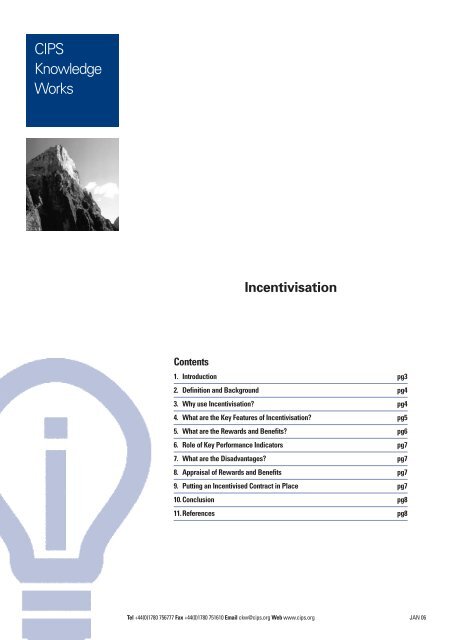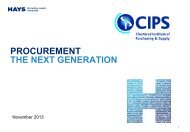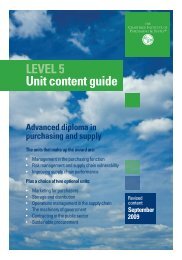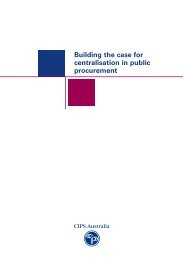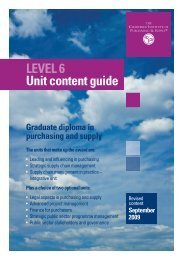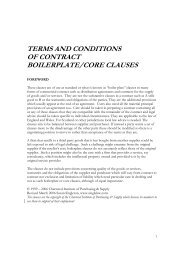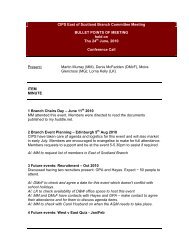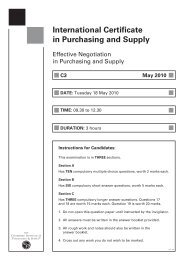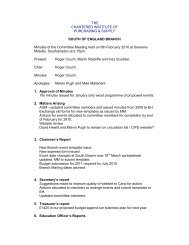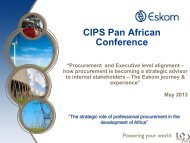Incentivisation - The Chartered Institute of Purchasing and Supply
Incentivisation - The Chartered Institute of Purchasing and Supply
Incentivisation - The Chartered Institute of Purchasing and Supply
You also want an ePaper? Increase the reach of your titles
YUMPU automatically turns print PDFs into web optimized ePapers that Google loves.
CIPS<br />
Knowledge<br />
Works<br />
Contents<br />
<strong>Incentivisation</strong><br />
1. Introduction pg3<br />
2. Definition <strong>and</strong> Background pg4<br />
3. Why use <strong>Incentivisation</strong>? pg4<br />
4. What are the Key Features <strong>of</strong> <strong>Incentivisation</strong>? pg5<br />
5. What are the Rewards <strong>and</strong> Benefits? pg6<br />
6. Role <strong>of</strong> Key Performance Indicators pg7<br />
7. What are the Disadvantages? pg7<br />
8. Appraisal <strong>of</strong> Rewards <strong>and</strong> Benefits pg7<br />
9. Putting an Incentivised Contract in Place pg7<br />
10. Conclusion pg8<br />
11. References pg8<br />
Tel +44(0)1780 756777 Fax +44(0)1780 751610 Email ckw@cips.org Web www.cips.org JAN 06
Welcome to a<br />
guide on<br />
<strong>Incentivisation</strong><br />
2 Tel +44(0)1780 756777 Fax +44(0)1780 751610 Email ckw@cips.org Web www.cips.org JAN 06
CIPS believes that P&SM pr<strong>of</strong>essionals should be<br />
knowledgeable about the range <strong>of</strong> tools <strong>and</strong> approaches<br />
relevant for incentivisation.<br />
1. INTRODUCTION<br />
<strong>The</strong> CIPS beliefs on incentivisation, which have been formulated with the role <strong>of</strong> the more senior <strong>Purchasing</strong><br />
<strong>and</strong> <strong>Supply</strong> Management (P&SM) pr<strong>of</strong>essional in mind, may be summarised as follows:<br />
• CIPS believes that all P&SM pr<strong>of</strong>essionals should develop/acquire the relevant tools <strong>and</strong> competencies<br />
necessary to manage the incentivisation process effectively<br />
• CIPS believes that the effect on the bottom line is a key determinant in any decision to apply incentivisation<br />
principles<br />
• CIPS encourages P&SM pr<strong>of</strong>essionals to exercise a ‘what if’ approach in the procurement process<br />
• CIPS is in favour <strong>of</strong> incentivisation where a clear business benefit is seen to accrue to the organisation<br />
• CIPS recommends that P&SM pr<strong>of</strong>essionals should adopt a proactive <strong>and</strong> positive approach to the contract<br />
management process – this encourages innovation <strong>and</strong> maximises customer satisfaction<br />
• CIPS believes that P&SM pr<strong>of</strong>essionals should be knowledgeable about the range <strong>of</strong> tools <strong>and</strong> approaches<br />
relevant for incentivisation.<strong>The</strong>y need not necessarily be experts in the application <strong>of</strong> all tools, but they<br />
should know where to obtain that expertise, eg from colleagues in finance.<br />
JAN06 Tel +44(0)1780 756777 Fax +44(0)1780 751610 Email ckw@cips.org Web www.cips.org 3
<strong>Incentivisation</strong><br />
2. DEFINITION AND BACKGROUND<br />
<strong>Incentivisation</strong> is defined in CUP (Central Unit on<br />
Procurement – forerunner <strong>of</strong> the OGC – Office <strong>of</strong><br />
Government Commerce) Guidance No 58 -<br />
‘<strong>Incentivisation</strong>’) as:<br />
‘A process by which a provider is motivated to<br />
achieve extra value added services over those specified<br />
originally <strong>and</strong> which are <strong>of</strong> material benefit to the<br />
user. <strong>The</strong>se should be attainable against pre-defined<br />
criteria. <strong>The</strong> process should benefit both parties’<br />
<strong>The</strong>refore there is some form <strong>of</strong> enhanced reward<br />
for the supplier whether it be financial or in some other<br />
form.<br />
It involves a process <strong>of</strong> mutually agreeing targets<br />
<strong>of</strong>ten with respect to cost, schedule, quality <strong>and</strong> safety<br />
or other measurable benefits to the client’s business<br />
such as;<br />
• inventory reduction<br />
• increased sales<br />
• reduced cost<br />
• improved labour utilisation<br />
<strong>The</strong> objective is the achievement <strong>of</strong> superior<br />
performance to the benefit <strong>of</strong> both parties, for which<br />
the supplier will receive additional reward. <strong>The</strong><br />
outcomes <strong>of</strong> the superior performance, whether lower<br />
cost, early delivery, safer or higher quality products are<br />
<strong>of</strong> obvious value to the buyer. <strong>Incentivisation</strong> might in<br />
some cases also lead to a partnering relationship<br />
between buyer <strong>and</strong> supplier.<br />
<strong>The</strong>re is a close relationship between incentivisation<br />
<strong>and</strong> risk management. Both techniques can be applied<br />
separately or together to ensure that contracts are<br />
successful. CIPS encourages all P&SM pr<strong>of</strong>essionals to<br />
constantly exercise a “what-if”mentality in relation to<br />
the procurement <strong>of</strong> goods, services or works.<strong>The</strong> “whatif”mindset<br />
will enable P&SM pr<strong>of</strong>essionals to determine<br />
the potential outcome <strong>of</strong> risk management <strong>and</strong><br />
incentivisation by testing the various assumptions,<br />
propositions <strong>and</strong> approaches under consideration.<br />
3. WHY USE INCENTIVISATION?<br />
From the buyer’s point <strong>of</strong> view, incentivisation is used<br />
to foster improvement by binding good suppliers with<br />
the expectation <strong>of</strong> even better reward. For the buyer,<br />
incentivisation <strong>of</strong>fers the possibility <strong>of</strong> self financing<br />
benefits from improved supplier performance <strong>and</strong> it<br />
also attracts good suppliers who see the potential for<br />
better rewards for their efforts <strong>and</strong> capabilities.<br />
<strong>The</strong> supplier might expect to gain extra financial<br />
reward but also an improved reputation as a successful<br />
supplier (which should lead to more work from the<br />
original buyer or from other buyers in the market<br />
place). In some markets, the possibility <strong>of</strong> a long-term<br />
multi contract relationship involving some form <strong>of</strong><br />
partnership sourcing is possible. This however is not<br />
so likely in the construction field where most<br />
relationships are single-project based.<br />
<strong>The</strong> following are examples <strong>of</strong> influential factors<br />
which might lead to incentivised contracts:<br />
Special Circumstances<br />
<strong>Incentivisation</strong> may be a product <strong>of</strong> circumstances<br />
which act to unite the buyer <strong>and</strong> supplier into a team<br />
devoted to the resolution <strong>of</strong> a particular issue. In such<br />
cases, the problem is seen as a common enemy which<br />
can only be overcome by the pooling <strong>of</strong> buyer <strong>and</strong><br />
supplier resources. It may arise from financial<br />
difficulty which threatens to overwhelm the existence<br />
<strong>of</strong> both parties, or it could be the outcome <strong>of</strong> a legal<br />
threat.<br />
Financial<br />
<strong>Incentivisation</strong> may take a purely financial form, for<br />
example, the buyer could have an earlier need for the<br />
product <strong>of</strong> the contract with the supplier than<br />
previously anticipated. Delivery <strong>of</strong> the product<br />
(whether a facility <strong>of</strong> some sort such as a building or<br />
an <strong>of</strong>f-shore installation or simply the supply <strong>of</strong> goods)<br />
could be financially beneficial to the buyer. <strong>The</strong>refore<br />
the buyer might be prepared to share some <strong>of</strong> the<br />
anticipated financial gain with the supplier as a reward<br />
for the effort needed to make earlier delivery.<br />
A specific example might be that <strong>of</strong> an <strong>of</strong>fshore oil<br />
company finding that it can sell the oil or gas from a<br />
major development earlier <strong>and</strong> more pr<strong>of</strong>itably than<br />
previously anticipated (perhaps the price <strong>of</strong> oil has<br />
unexpectedly risen significantly). It could now be<br />
worthwhile for such a company to l<strong>and</strong> the oil earlier<br />
<strong>and</strong> to achieve this end, the company is prepared to<br />
share some <strong>of</strong> the gain with the suppliers who are<br />
constructing the platform.<br />
At the other extreme, it is possible to envisage a<br />
company which is considering the re-decoration <strong>of</strong> a<br />
meeting room. <strong>The</strong> lead times quoted by the<br />
decorating suppliers would mean that the buyer would<br />
have to hire a room elsewhere for some important<br />
function. If the buyer could strike a deal with the<br />
supplier whereby the buyer would pay the supplier<br />
extra for earlier completion <strong>of</strong> the room, then,<br />
providing the extra amount paid to the supplier were<br />
less than the cost <strong>of</strong> hiring another room, both parties<br />
would gain.<br />
Financial incentivisation could also be used to<br />
stimulate suppliers to beat cost targets embodied in the<br />
contract. This is appropriate in cases where the target<br />
cost acts as a cap to the amount which the buyer is<br />
prepared to pay. If the supplier can deliver the<br />
requirements <strong>of</strong> the contract for less cost than the<br />
target cost, the difference can be divided in some<br />
agreed proportion between the buyer <strong>and</strong> the supplier.<br />
4 Tel +44(0)1780 756777 Fax +44(0)1780 751610 Email ckw@cips.org Web www.cips.org JAN 06
Non- project incentivisation:<br />
<strong>The</strong> above examples all suggest that incentivisation may<br />
only be used for projects or as a component <strong>of</strong><br />
contracts for discrete services. However, this does not<br />
need to be the case. <strong>Incentivisation</strong> can be a part <strong>of</strong><br />
contracts to produce goods. In this case, the<br />
incentivisation could be to reduce cost, improve design,<br />
reduce stocks, speed delivery etc.<br />
Non-financial incentivisation:<br />
While incentivisation can be <strong>of</strong> a straightforward<br />
financial nature, ie money, it can also be for money’s<br />
worth to the supplier. For example, it would be worth<br />
something to suppliers to be assured <strong>of</strong> a continuity <strong>of</strong><br />
business <strong>and</strong> this assurance could be the<br />
incentivisation. Similarly, some suppliers could gain<br />
kudos from an association with an outst<strong>and</strong>ingly<br />
successful contract <strong>and</strong> this can also act as an incentive.<br />
4 WHAT ARE THE KEY FEATURES OF<br />
INCENTIVISATION?<br />
<strong>Incentivisation</strong> is contract based that might, but not<br />
necessarily be based on agreement <strong>and</strong> trust between<br />
buyer <strong>and</strong> supplier. However, without a genuine<br />
meeting <strong>of</strong> minds, an incentivised contract is likely to be<br />
viewed in a negative light, most probably by the<br />
supplier, who could see it as simply another contractual<br />
device imposed by the buyer to enforce performance.<br />
This means that the reward which the supplier receives<br />
must be commensurate with the extra effort required.<br />
Conversely, the value <strong>of</strong> the incentivisation which the<br />
buyer receives should be commensurate with the<br />
amount to be paid.<strong>The</strong> incentivisation must be seen by<br />
both parties to be win-win, with no hidden agendas.<br />
Mutual trust <strong>and</strong> a drive to continuously improve are<br />
desirable. For example, where the incentives are<br />
concerned with cost minimisation, there will be a need<br />
for both parties to practise open book costing.<br />
Contractual incentive schemes need to reflect the<br />
business objectives <strong>of</strong> the buyer <strong>and</strong> coincide with the<br />
business objectives <strong>of</strong> the supplier. <strong>The</strong>y should be<br />
simple <strong>and</strong> measurable so as to avoid dispute both<br />
about their meaning <strong>and</strong> their attainment. <strong>The</strong>y should<br />
preferably be based on outputs so that deliverables can<br />
be easily identified <strong>and</strong> they should take account <strong>of</strong><br />
what might happen during the life <strong>of</strong> the contract.<br />
<strong>Incentivisation</strong> requires closer <strong>and</strong> more detailed<br />
dialogue between the buyer <strong>and</strong> supplier, both at the<br />
pre-contract stage <strong>and</strong> during post-contract<br />
management. This is because <strong>of</strong> the greater need to<br />
attend to performance <strong>and</strong> its measurement if the<br />
milestones associated with the incentives are to be<br />
unequivocally attained, thus clearly justifying payment<br />
<strong>of</strong> the incentive. Lack <strong>of</strong> clarity associated with the<br />
attainment <strong>of</strong> a milestone can, <strong>of</strong> course, breed mistrust<br />
which will sour relationships.<br />
<strong>Incentivisation</strong> arrangements should not be seen as<br />
an end in themselves <strong>and</strong> should only be used where<br />
appropriate. This means that the cultures which exist<br />
within both the supplier’s <strong>and</strong> the buyer’s organisations<br />
must be compatible. Above all, the concept needs wide<br />
acceptance within many departments <strong>and</strong> at many<br />
levels <strong>of</strong> management in both organisations. It <strong>of</strong>ten<br />
needs to include all stakeholders. Agreement between<br />
the buyer’s purchasing <strong>and</strong> contracts department <strong>and</strong><br />
the supplier’s sales department is not sufficient.<br />
<strong>Incentivisation</strong> is naturally dependent on the buyer’s<br />
ability to pay. This requires the buyer to carefully assess<br />
the likely cost <strong>of</strong> any incentivisation <strong>and</strong> to take steps to<br />
ensure that the purchasing organisation provides the<br />
funds to make any payment. Where the incentivisation<br />
does not have some form <strong>of</strong> cap, or upper limit, ie is<br />
open-ended, there could be the possibility <strong>and</strong> risk <strong>of</strong><br />
the amounts <strong>of</strong> payment exceeding the funds allocated<br />
for this purpose. This could have severe repercussions,<br />
particularly if the incentivisation is associated with the<br />
completion <strong>of</strong> the project on cost target.<br />
<strong>Incentivisation</strong> could be multi-target in nature. This<br />
means that there could be more than one target for the<br />
supplier to achieve. <strong>The</strong> achievement <strong>of</strong> each target is<br />
considered individually. So, failure to achieve one target<br />
does not impact on the supplier’s reward for some<br />
other target should that target be achieved. <strong>The</strong><br />
supplier is thus not de-motivated by failure <strong>and</strong>, because<br />
the overall scheme is fair, it might be that motivation is<br />
enhanced.<br />
With respect to projects, the buyer needs to<br />
consider carefully the implications to all the<br />
participants (client, contractors, consultants, key<br />
subcontractors, ultimate customers etc ) <strong>of</strong> the<br />
incentivisation process. For example, there is little<br />
point in independently incentivising some aspect <strong>of</strong> a<br />
contractor’s contract if that part is crucially dependent<br />
upon another party, say a consultant or the client,<br />
neither <strong>of</strong> whom are a party to the incentivisation. <strong>The</strong><br />
involvement <strong>of</strong> the other participants might require<br />
them to be incentivised themselves, the most likely<br />
examples being subcontractors <strong>and</strong> consultants.<br />
Alternatively, in the case <strong>of</strong> clients, there is a need for<br />
an awareness <strong>and</strong> an underst<strong>and</strong>ing <strong>of</strong> the<br />
incentivisation <strong>and</strong> the reasons for it.<br />
<strong>Incentivisation</strong> <strong>of</strong> many contracts within a project<br />
requires careful management. Multiple incentivisation<br />
must lead to complementary outcomes if disruption is<br />
to be avoided. This is because all the parties in a project<br />
tend to rely on others <strong>and</strong> the consequence <strong>of</strong><br />
uncoordinated incentivisation can upset this reliance.<br />
Organisations which have not previously used<br />
incentivisation need to proceed with caution until a<br />
level <strong>of</strong> experience is achieved. A policy <strong>of</strong> ‘keeping it<br />
simple’ is advisable.<br />
JAN06 Tel +44(0)1780 756777 Fax +44(0)1780 751610 Email ckw@cips.org Web www.cips.org 5
<strong>Incentivisation</strong><br />
<strong>Incentivisation</strong> can work across a series <strong>of</strong> contracts.<br />
This assists in the learning <strong>of</strong> the buyer <strong>and</strong> the<br />
supplier, assuming that the same supplier has been used<br />
for each <strong>of</strong> the contracts. This can lead to greater levels<br />
<strong>of</strong> efficiency in the later contracts.<br />
In a study undertaken by the Treasury <strong>and</strong> other<br />
government departments some time ago, the following<br />
were identified as key factors in successfully using<br />
incentivisation as a technique:<br />
• a firm <strong>and</strong> detailed basis for costing a contract both<br />
for the buyer <strong>and</strong> the supplier<br />
• effective measurements <strong>and</strong> setting <strong>of</strong> milestones<br />
<strong>and</strong> targets for both buyer <strong>and</strong> supplier, this means<br />
that a good quality specification is essential <strong>and</strong><br />
there should also be a good audit trail<br />
• the need for effective contract management within<br />
an incentivised contract which commences at the<br />
correct time<br />
• a requirement for transparent structures in respect<br />
<strong>of</strong> cost <strong>and</strong> performance by both parties operating<br />
within this sphere<br />
• good payment procedures to ensure that payment is<br />
made as agreed<br />
• willingness on the part <strong>of</strong> the supplier to participate<br />
in the incentivisation scheme.<br />
<strong>The</strong>re can also be an incentive to avoid a negative<br />
consequence. <strong>The</strong> most usual form could be liquidated<br />
damages. Other examples could be loss <strong>of</strong> reputation,<br />
or withdrawal <strong>of</strong> any further business.<br />
5. WHAT ARE THE REWARDS AND BENEFITS?<br />
Both buyers <strong>and</strong> suppliers are able to benefit from<br />
incentivisation.<br />
From the buyer’s point <strong>of</strong> view, the benefits to the<br />
buying organisation are likely to include:<br />
• lower cost, faster or more timely delivery <strong>of</strong> service<br />
• improved quality or safety<br />
• earlier delivery with the possibility <strong>of</strong> an earlier<br />
revenue stream<br />
• a more knowledgeable <strong>and</strong> skilful workforce arising<br />
from the experience <strong>of</strong> open book costing<br />
• additional services from the supplier<br />
• possibly a longer relationship with a good supplier<br />
• less time spent resolving contractual disputes<br />
• better price stability<br />
• improved management information<br />
• improved monitoring <strong>and</strong> control.<br />
From the supplier’s point <strong>of</strong> view, the benefits are likely<br />
to include:<br />
• faster payment<br />
• better reputation<br />
• longer relationships with the buyer possibly<br />
• less time spent on contractual disputes.<br />
CIPS defines a “benefit”as that which the buying<br />
organisation receives as a result <strong>of</strong> the supplier<br />
delivering something desirable over <strong>and</strong> above the basic<br />
contract requirement. Benefits can be shared with the<br />
supplier if, for instance, a greater margin is achieved<br />
through the supplier achieving a target for innovation in<br />
respect <strong>of</strong> a particular product.<br />
CIPS encourages incentivisation where a real<br />
business benefit accrues to the buying organisation ie<br />
constructing a contract so that the supplier has an<br />
incentive to deliver not only what is required by the<br />
buying organisation, but - as appropriate or necessary –<br />
exceed those requirements. CIPS believes that if this is<br />
done correctly it will deliver the best possible contract<br />
<strong>and</strong> value for money.<br />
In practice, incentivisation usually involves the<br />
employment <strong>of</strong> rewards, benefits or sometimes<br />
liquidated damages, or equivalent, in contracting.This<br />
policy encourages the use <strong>of</strong> rewards <strong>and</strong> benefits<br />
when incentivising contracts.<br />
CIPS defines a reward as something, usually money,<br />
which the supplier receives from the buying<br />
organisation, for achieving an objective, or a desirable<br />
outcome, which is over <strong>and</strong> above the basic<br />
requirements <strong>of</strong> the contract.<br />
Financial return is the biggest incentive for most<br />
suppliers. If the buying organisation would benefit from,<br />
for example, eg a construction project completed earlier<br />
than the contract states, then a financial incentive for an<br />
early finish can encourage suppliers <strong>and</strong> facilitate a winwin<br />
situation. However, P&SM pr<strong>of</strong>essionals should<br />
ensure that incentives are not introduced too early in a<br />
negotiation as there is a danger that the original<br />
contract requirement may get diluted as the supplier<br />
seizes an opportunity to obtain more from the contract.<br />
Indeed, CIPS emphasises the fact that negotiators must<br />
not give away the essence <strong>of</strong> the deal when negotiating<br />
incentives.<br />
CIPS recommends that in the early stages <strong>of</strong> a<br />
procurement process the P&SM pr<strong>of</strong>essional should<br />
identify, whether or not there are any real business<br />
benefits to be had from incentivising a contract; this<br />
should also determine the extent <strong>of</strong> such incentives.<br />
If there is little to be gained, over <strong>and</strong> above that<br />
which is required from the st<strong>and</strong>ard contractual<br />
arrangement, then there may be no point in pursuing<br />
incentivisation. CIPS would argue, however, that any<br />
contract should be subject to proactive contract<br />
management <strong>and</strong> continual improvement. It should<br />
encourage innovation <strong>and</strong> the delight <strong>of</strong> customers, <strong>and</strong><br />
so some mechanism to encourage such commitment<br />
from suppliers should appear in most contracts.<br />
It is useful to structure the reward package so as to<br />
align the objectives <strong>of</strong> the buying organisation <strong>and</strong> the<br />
supplier.<strong>The</strong> first step is to choose an appropriate<br />
contract form. For example, a lump sum will align the<br />
6 Tel +44(0)1780 756777 Fax +44(0)1780 751610 Email ckw@cips.org Web www.cips.org JAN 06
parties if the lowest cost is the prime concern, but not<br />
if the highest quality is what is required from the<br />
contract. Having set a basic form, the next step is to<br />
provide further encouragement to align. This can<br />
facilitate, for instance, the buying organisation paying<br />
additional fees to the service provider, eg architects, if<br />
the cost <strong>of</strong> the total project is reduced or if the faults<br />
occurring after completion are less than x%.<br />
6. ROLE OF KEY PERFORMANCE INDICATORS (KPIs)<br />
KPIs are fundamental to incentivisation.<strong>The</strong> supplier’s<br />
pr<strong>of</strong>it <strong>and</strong> possibly overheads <strong>and</strong> even direct costs<br />
should be at risk if the contractual KPIs are not met.<strong>The</strong><br />
KPIs can be graduated so that poor, satisfactory, good<br />
<strong>and</strong> excellent performance may be determined.<strong>The</strong><br />
supplier earns, for example, a lesser amount <strong>of</strong><br />
pr<strong>of</strong>it/overhead (or none at all) for poor performance as<br />
opposed to excellent performance where the<br />
contractor might expect to receive their normal margin<br />
plus the extra amount. So the term ‘risk’ applies to the<br />
amount <strong>of</strong> pr<strong>of</strong>it/overhead the supplier is prepared to<br />
risk in the incentivisation scheme <strong>and</strong> the reward is<br />
what they actually receive; this will vary depending on<br />
their performance from a poor rate <strong>of</strong> return to an<br />
excellent one.<br />
It is normal to balance such schemes so that the<br />
amount the supplier puts at risk (the downside) is equal<br />
to the amount they could earn over <strong>and</strong> above the<br />
normal margin expected for a satisfactory or good<br />
performance (the upside).<br />
<strong>The</strong> KPIs are measures <strong>of</strong> business-critical<br />
deliverables such as:<br />
• Achieving the scope <strong>of</strong> work within budget<br />
• Delivering the required amount <strong>of</strong> production per<br />
month every month<br />
• Performing work without any safety <strong>and</strong> production<br />
critical maintenance work every month<br />
KPIs should be easily measurable, tangible <strong>and</strong> critical<br />
for the success <strong>of</strong> the contract <strong>and</strong> business.<br />
7. APPRAISAL OF REWARDS/BENEFITS<br />
CIPS suggests that for any significant contract the P&SM<br />
pr<strong>of</strong>essional should produce a strategy for that<br />
procurement, including a business case as appropriate.<br />
<strong>The</strong> business case should include an investment<br />
appraisal which should illustrate what is required from<br />
the contract; <strong>and</strong> what other benefits are required in<br />
addition, eg working with supplier to reduce costs <strong>of</strong><br />
product X over the contract period. By defining the<br />
investment in this way at the outset, the management<br />
<strong>and</strong> monitoring <strong>of</strong> the contract should be much easier<br />
as the buying organisation will have the information<br />
with which to measure progress.<br />
When developing a business case, P&SM should seek<br />
the assistance <strong>of</strong> their colleagues in finance particularly<br />
when undertaking the investment appraisal, as financial<br />
modelling <strong>and</strong>/or sensitivity analysis may be required.<br />
<strong>The</strong> financial modelling <strong>and</strong> sensitivity analysis may<br />
identify that a cut-<strong>of</strong>f point is needed in respect <strong>of</strong><br />
rewards to suppliers to prevent super pr<strong>of</strong>its being<br />
generated. Similarly, cost-benefit analysis may be<br />
appropriate for those benefits which are not an obvious<br />
advantage.<br />
CIPS suggests that all benefits/rewards within a<br />
contract should be:<br />
• tangible<br />
• achievable<br />
• measurable<br />
• agreed by all parties<br />
Even s<strong>of</strong>ter benefits can be measured such as<br />
improved communications between supplier <strong>and</strong> end<br />
users as evidenced by improved scores on a feedback<br />
survey.<br />
If additional incentivisation is required mid-contract,<br />
then a contract amendment or change order may be<br />
required.<br />
8. WHAT ARE THE DISADVANTAGES OF<br />
INCENTIVISATION?<br />
It must be stressed that incentivisation should not be<br />
seen as a panacea for the many problems which can<br />
impact on large-value, long-term contractual<br />
arrangements. It is not easy nor is it a quick fix because<br />
it requires time, considerable thought <strong>and</strong> planning for<br />
it to work effectively. It is a co-operative <strong>and</strong> collective<br />
approach rather than a unilateral process, which means<br />
that it cannot be imposed by the purchasing<br />
department acting independently. Rather, it needs the<br />
support <strong>and</strong> active participation <strong>of</strong> colleagues within<br />
the buying organisation <strong>and</strong> <strong>of</strong> the staff within supplier<br />
organisations.<br />
For the supplier, there is the risk <strong>of</strong> investing this<br />
time <strong>and</strong> not winning any business. For the buyer, the<br />
investment <strong>of</strong> this time could be with many suppliers <strong>of</strong><br />
which only one will get the business.<br />
<strong>The</strong>re is also the risk that the effort involved in<br />
establishing an incentivised arrangement will not equate<br />
with the extra outcomes from this arrangement.<br />
9. PUTTING AN INCENTIVISED CONTRACT IN PLACE<br />
As part <strong>of</strong> the process <strong>of</strong> establishing an incentivised<br />
contract, it has been suggested that the following<br />
questions should be asked by the party initiating this<br />
type <strong>of</strong> relationship::<br />
JAN06 Tel +44(0)1780 756777 Fax +44(0)1780 751610 Email ckw@cips.org Web www.cips.org 7
<strong>Incentivisation</strong><br />
• From the buyer’s point <strong>of</strong> view, is incentivisation<br />
worth doing?<br />
• Can the contract objectives/deliverables be defined<br />
in such a way that incentivisation is possible?<br />
• What would the incentives be?<br />
• Is there sufficient time to develop an incentivised<br />
contract strategy?<br />
• Are there any constraints such as culture within the<br />
buyer’s organisation to the use <strong>of</strong> incentives?<br />
• Are the suppliers likely to be receptive to a proposal<br />
that they undertake an incentivised contract?<br />
• Will the proposed incentives be <strong>of</strong> interest to the<br />
supplier?<br />
• Can the incentivised targets be measured objectively<br />
by both parties to the contract <strong>and</strong> is an audit trail<br />
possible?<br />
• What are the risks associated with using<br />
incentivisation? Are they acceptable?<br />
• Do both buyer <strong>and</strong> supplier have the skills to<br />
manage an incentivised relationship?<br />
• Are there terms <strong>and</strong> conditions suitable for an<br />
incentivised contract <strong>and</strong>, if not, can they be<br />
developed?<br />
For incentivisation to be a realistic tool there must<br />
be real, achievable <strong>and</strong> measurable targets <strong>and</strong> stated<br />
benefits with both parties being willing to sign up to<br />
them.<strong>The</strong>re are contracts for which incentivisation<br />
might not be suitable <strong>and</strong> there is clearly little point in<br />
using incentivisation if the desired results can be<br />
achieved by other means.<br />
For utilities <strong>and</strong> for the public sector, incentivisation<br />
should not conflict with the EU Procurement Directives<br />
provided the method <strong>of</strong> awarding a contract is the most<br />
economically advantageous <strong>and</strong> provided that the<br />
method <strong>and</strong> criteria for assessing which bid is the most<br />
economically advantageous have been clearly publicised<br />
in accordance with the requirements <strong>of</strong> the Directives<br />
<strong>and</strong> subsequently adhered to.<br />
It has been suggested in a review <strong>of</strong> incentivisation<br />
undertaken by a Treasury working party some time ago<br />
that the following can act as constraints to the use <strong>of</strong><br />
incentivisation in the public sector:<br />
• European procurement legislation: This will affect<br />
the public sector, utilities <strong>and</strong> the oil <strong>and</strong> gas<br />
exploration <strong>and</strong> production industries<br />
• <strong>The</strong> requirement for public accountability<br />
• Existing cultures in both the buyer <strong>and</strong> the supplier<br />
organisations. <strong>The</strong>re could be opposition from the<br />
client or the user department within the buyer’s<br />
organisation who might not like the concept<br />
• A perception that the process is in some way unfair<br />
• Insufficient time to plan <strong>and</strong> to implement the<br />
processes needed to generate the incentivised<br />
rewards<br />
• <strong>The</strong> scope <strong>of</strong> the contracts is too limited for<br />
incentivisation to apply<br />
• Fear that it will cost too much. This has been partly<br />
addressed above by the reference to the need to<br />
ensure that adequate funds are made available<br />
• A concern that it might not be possible to have<br />
contracts without incentivisation with a supplier, if<br />
already involved in incentivised contracts with that<br />
supplier. <strong>The</strong> result being a loss <strong>of</strong> flexibility.<br />
It is worth noting that many <strong>of</strong> the above<br />
considerations could also apply to organisations in the<br />
private sector.<br />
10. CONCLUSION<br />
<strong>Incentivisation</strong> is a key element in the P&SM<br />
pr<strong>of</strong>essional’s toolkit. He or she has an important<br />
role to play in maximising the benefits <strong>of</strong> any<br />
incentivisation process. It is stressed that<br />
collaboration with other departments (typically,<br />
finance) is a key factor – the P&SM function cannot<br />
<strong>and</strong> should not be expected to operate on a<br />
st<strong>and</strong>alone basis: ‘CIPS believes that P&SM<br />
pr<strong>of</strong>essionals need not necessarily be experts in the<br />
application <strong>of</strong> all tools, but should know where to<br />
obtain that expertise’.<br />
11. REFERENCES<br />
Books<br />
Why Use St<strong>and</strong>ard Forms <strong>of</strong> Contract<br />
P Capper FIDIC, (French acronym for ‘International<br />
Federation <strong>of</strong> Consulting Engineers)<br />
Management <strong>of</strong> Procurement<br />
D Bower,Thomas Telford Services<br />
Construction Contract Incentive Schemes – Lessons<br />
from Experience<br />
D Richmond-Coggan, CIRIA<br />
Value Management <strong>of</strong> Construction Contracts<br />
John Kelly et al<br />
<strong>Incentivisation</strong><br />
CUP Guidance No 58<br />
Office <strong>of</strong> Government Commerce<br />
Articles<br />
Articles on incentivisation, again with a construction<br />
industry emphasis, may be found in the CIOB<br />
(<strong>Chartered</strong> <strong>Institute</strong> <strong>of</strong> Building) publication<br />
‘Construction Information Quarterly’ (website<br />
www.extenza.eps.com)<br />
8 Tel +44(0)1780 756777 Fax +44(0)1780 751610 Email ckw@cips.org Web www.cips.org JAN 06
Websites<br />
<strong>The</strong>se include:<br />
• www.rics.org<br />
• www.ciria.org<br />
• www.fidic.org<br />
• www.ogc,gov.uk<br />
• www.pwcglobal.com<br />
• www.constructingexcellence.org.uk<br />
AUTHOR<br />
CIPS Pr<strong>of</strong>essional Practice Team<br />
JAN06 Tel +44(0)1780 756777 Fax +44(0)1780 751610 Email ckw@cips.org Web www.cips.org 9


